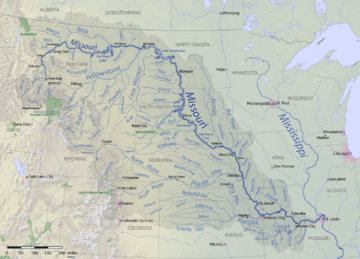Spread Eagle (steamboat) facts for kids
The Spread Eagle was a big steamboat that used steam power and large wheels on its sides to move. It traveled along the Missouri River from 1857 to 1864. This boat carried people, goods, and supplies to forts and trading posts. It was built in Brownsville, Pennsylvania.
The Spread Eagle was a wooden boat, 210 feet long and 36 feet wide. It needed 6 feet of water to float. The boat was powered by two steam engines, each with three large boilers. These boilers were 40 inches wide and 24 feet long. Captain Benjamin Johnson built the Spread Eagle. He sold it to the American Fur Company when it arrived in St. Louis. Captain Bailey commanded the boat. Once, it even raced another boat on the Missouri River and bumped into it!
What the Spread Eagle Did

The Spread Eagle carried goods and traded from St. Louis to Omaha, Nebraska and Council Bluffs, Iowa. On June 6, 1862, it had a race against another steamboat called the Emilie. This race happened on the upper Missouri River near Fort Berthold in the Dakota Territory.
In 1859, the American Fur Company sent two boats up the Missouri River. These boats carried supplies and men for their yearly trips. The company used its new boat, the Spread Eagle, and a rented boat called the Chippewa. The Chippewa was a lighter boat. Its owner, Captain Crabtree, was supposed to take it all the way to Fort Benton, Montana.
At Fort Union Trading Post National Historic Site, Captain Crabtree could not finish his trip. So, the Chippewa was sold to the American Fur Company. Goods from the Spread Eagle were then moved onto the Chippewa.
Captain Joseph LaBarge commanded the Spread Eagle. His brother, John, took charge of the Chippewa. On July 17, 1859, the Chippewa made it very close to Fort Benton. It unloaded its cargo at a place called Brule bottom. This boat reached a point further from the sea by river than any other boat before it!
The Big Race with the Emilie
The Spread Eagle was owned by the American Fur Company in Saint Louis. In early 1862, Captain Joseph LaBarge and his friends started a new company. It was called LaBarge, Harkness & Co. This company also traded on the upper Missouri River. The American Fur Company was their biggest rival.
Both companies were getting ready for their yearly trip up the Missouri River. They were loaded with supplies and men. The American Fur Company wanted to be first to Fort Benton. So, the Spread Eagle left Saint Louis first, with Captain Robert E. Bailey in charge. Three days later, Captain LaBarge left with the Emilie, which was a faster boat. The Emilie eventually caught up to the Spread Eagle at Fort Berthold and passed it.
The crews of both boats had a strong rivalry. People had even made bets about which boat would reach Fort Benton first. This was because the Emilie's pilot, William Massie, was known for making fast trips.
When Captain Bailey realized he was losing, he tried a risky move. The two boats were coming up to an island in the river. There were narrow paths on both sides. The Spread Eagle went through the wider path. But the Emilie went through what Bailey thought was too narrow to pass. This path was actually shorter.
The two boats were less than 50 feet apart. Bailey saw he was about to be left behind. He told his pilot, William Massie, to turn the boat on purpose. He wanted to crash the front of the Spread Eagle into the Emilie, very close to its engines. This was a very dangerous thing to do! Luckily, the Emilie only had minor damage.
Captain LaBarge was watching from his boat. He was shocked that the American Fur Company would try such a dangerous trick. He immediately told the Spread Eagles pilot to stop his engines and fall back. He even threatened to use weapons if they didn't. LaBarge's threats worked. The Spread Eagles captain ordered his boat to fall back. The Spread Eagle was not seen again during the race. The Emilie reached Fort Benton and won the race by four days. The Spread Eagle finally arrived on June 20.
When the Spread Eagle returned to Saint Louis, Captain Bailey faced trouble for his dangerous actions. He had put passengers at risk and damaged the Emilie. When Bailey was investigated, he lost his license to be a captain. William Massie then became the new captain of the Spread Eagle.
Being a steamboat captain was Bailey's only job. Losing his license was a big problem, especially since he had a large family to support. About a month later, Bailey asked LaBarge for help. He said the inspector would not give him his license back unless LaBarge supported him. Bailey admitted he was wrong and said he felt pressured by his company. He begged LaBarge to help him get his job back for his family's sake. LaBarge finally agreed. He spoke with the inspector, and Bailey got his license back.
Two years after the race, on March 20, 1864, the Spread Eagle hit something hidden in the water and sank at Pinckney Bend.

